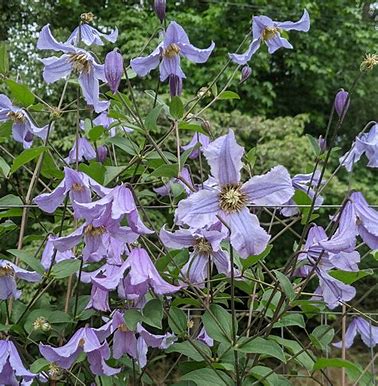Riverdene Garden Center
Blue Boy Clematis
Blue Boy Clematis
Couldn't load pickup availability
Clematis integrifolia ‘Blue Boy’
Blue Boy Clematis is a cold-hardy, compact, herbaceous clematis known for its large, nodding blue-violet flowers with wavy edges. Unlike traditional clematis vines, Blue Boy is a non-climbing, bushy clematis that grows in a mounded, sprawling habit, making it ideal for borders, rock gardens, and mixed perennial plantings. Blooming from early summer to fall, it provides long-lasting color in Southwest Saskatchewan gardens.
Planting & Growing Conditions
- Hardiness Zone: 3-7 (extremely winter-hardy, perfect for prairie climates)
- Mature Size: 2-4 feet tall, 2-3 feet wide (non-climbing, bushy form)
- Growth Rate: Moderate
-
Sunlight Needs:
- Full sun to partial shade (best flowering with at least 6 hours of direct sun)
- Prefers afternoon shade in hotter regions to prevent fading
-
Soil Requirements:
- Prefers moist, well-drained, fertile soil
- Tolerates clay, sandy, or loamy soils (pH range 6.0-7.5)
- Avoid overly wet conditions, as clematis dislikes standing water
- Spacing: 2-3 feet apart for proper air circulation
Watering & Maintenance
-
Young Plants (First Year):
- Water deeply 2-3 times per week to establish roots
-
Established Plants:
- Water weekly, especially in dry periods
- Prefers consistent moisture but does not tolerate soggy soil
-
Mulching:
- Apply a 2-3 inch layer of mulch around the base to retain moisture and keep roots cool
Fertilizing
- First Year: No fertilizer needed—focus on root establishment
-
Mature Plants:
- Apply a balanced fertilizer (e.g., 10-10-10) in early spring
- Supplement with bone meal or compost to promote strong root growth
- Avoid excess nitrogen, which encourages excessive foliage over flowers
Pruning & Maintenance
Blue Boy Clematis belongs to Pruning Group 3, meaning it blooms on new growth each year.
- Best Time to Prune: Late winter to early spring, before new growth starts
-
How to Prune:
- Cut back all stems to 6-12 inches above ground level in early spring
- Removing old growth encourages vigorous new stems and abundant flowers
- Deadhead spent flowers to extend blooming
Flowers, Foliage & Seasonal Interest
- Bloom Time: Early summer through fall (June-September)
-
Flower Color:
- Violet-blue, nodding bell-shaped flowers with wavy edges
- Medium-sized blooms (2-3 inches wide)
- Fragrance: Mild to none
-
Foliage:
- Spring & Summer: Lush green, lance-shaped leaves
- Fall: Leaves turn yellow before dropping
Pest & Disease Management
Resistant to: Deer, rabbits, and most pests
Common Pests:
-
Aphids – Can cause leaf curling
- Solution: Spray with insecticidal soap or introduce ladybugs
-
Slugs & Snails – May feed on tender shoots
- Solution: Use crushed eggshells or diatomaceous earth around the base
Common Diseases:
-
Clematis Wilt (Fungal Disease) – Causes sudden wilting of stems
- Solution: Remove affected stems and ensure good air circulation
-
Powdery Mildew – White fungal coating on leaves in humid conditions
- Solution: Improve airflow and apply an organic fungicide if needed
Winter Protection
- Highly winter-hardy—no special protection needed in Zone 3+
-
Mulching:
- Apply 2-4 inches of mulch around the base for added root insulation
- Cut back in late winter or early spring to encourage healthy new growth
Landscape Uses
Perfect for borders, rock gardens, and perennial beds
Does not require a trellis—can be used as a ground cover or supported by other plants
Compact habit makes it great for small gardens and containers
Long blooming period from summer to fall
Attracts bees and butterflies
Companion Planting Ideas:
- Ornamental Grasses – Adds contrast and texture to the garden
- Salvia & Coneflowers – Complementary colors and extended bloom time
- Hostas & Astilbes – Provide shade to the base while adding foliage interest
- Roses & Shrubs – Use as an underplanting for taller specimens
Additional Notes:
- Blue Boy Clematis is a low-maintenance, free-flowering perennial
- Lifespan: 20+ years with proper care
- Ideal for naturalized and cottage-style gardens
Photo courtesy of brushwoodnursery.com
Share


